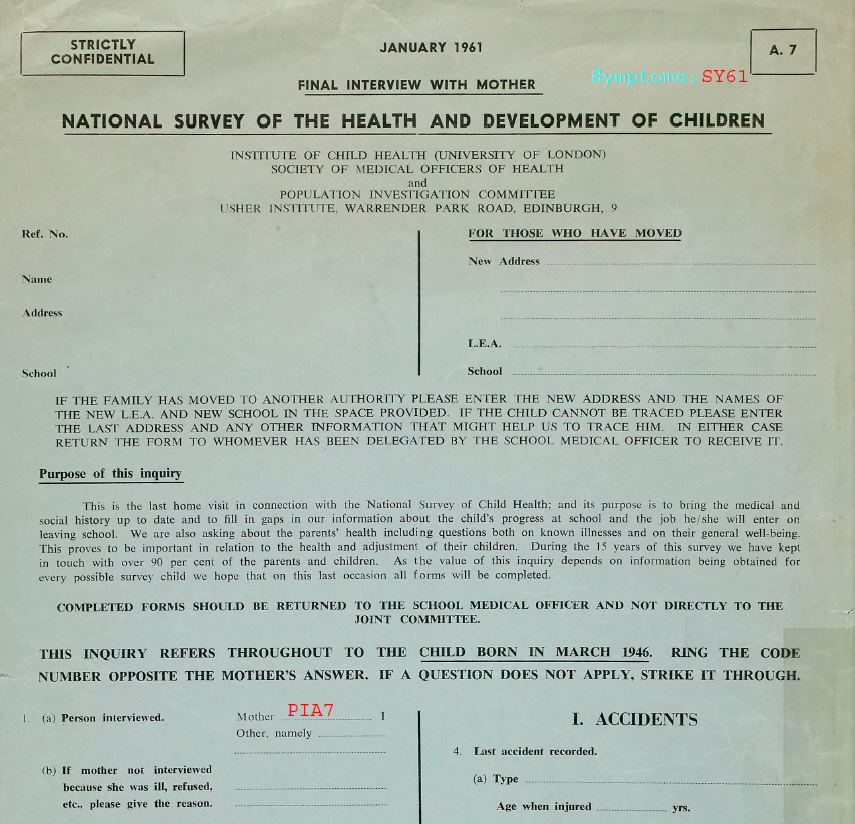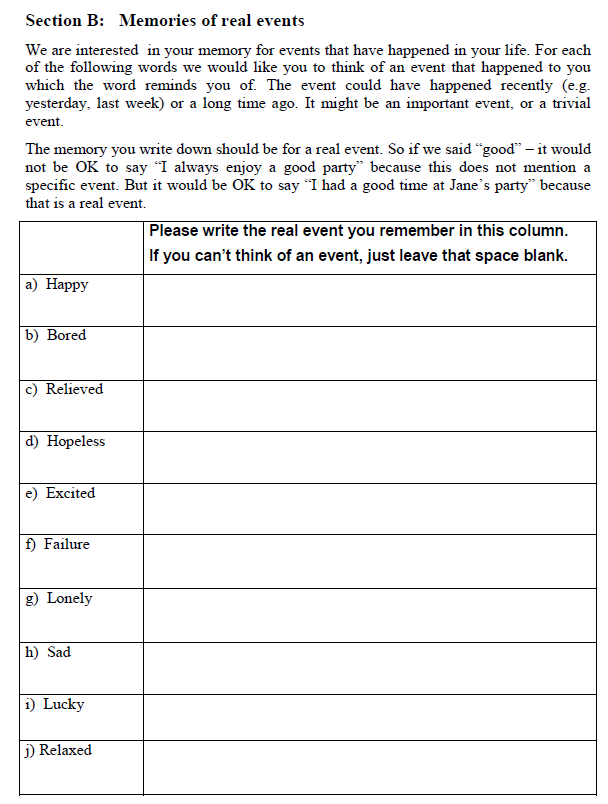...
| Info | ||
|---|---|---|
| ||
|
Text within a questionnaire becomes a statement when it does not fulfill the criteria of becoming any of the other elements and does not provide any context to be part of (Sequence, Instruction, Condition or Question). It must not contain any context which is not already included in the question literal. Statements can be found throughout the questionnaire; at the beginning, middle and end.
Statements They can be used for questions and sequences. referenced to both questions or sequences depending on their location and content.
Statements are control constructs like sequences, conditions and question components. Constructs that are independent of questions. Control constructs are concerned with positioning items within a questionnaire.
Statements are different from instructions. There are places where an instruction becomes a statement because there is more than one instruction and only one can be input as an instruction, see example from NSHD below. The following are examples of statements in questionnaires from different studies:
ALSPAC:
The following example contains a statement 'If no, go to C2 below'. It also contains a condition 'If yes,' - see here for more on conditions.
ALSPAC:
This is an example of a question which consists of the question literal text as well as a statement. However, the text is continuous it therefore is not as clear as to which parts of the text classify as the statement. Upon further analysis if becomes more evident that the second part of the statement becomes a statement and the first paragraph becomes the question literal.
Note also that when constructing the id label for this statement, it's reference is the sequence 'Section B:...' and therefore the label should be entered as the following 's_SectionB_i'. It has also been numbered as all statements that are referenced back to a sequence need to be numbered even if there is only one statement.
BCS:
The text highlighted in this example 'HERE ARE SOME QUESTIONS ABOUT COUGHS AND COLDS' may be mistaken for a sequence however it is actually a statement. This is because it does not satisfy the requirements of a sequence in having an clear start and end. See here for more on sequences.
US:
This could also be mistaken for a sequence like the example above but it is entered as a statement.
NSHD
This example contains instructions for the questionnaire however the text is still entered as multiple statements.
NSHD
This example is of a question with more than one apparent instruction.
Statements need to refer back to a question or a sequence to provide them with unique labels. This helps to understand their position within the questionnaire. Statements are labelled with the prefix ‘s_intro_…’. If there is a statement connected to a section then it always needs to be numbered even if there is only one, see second example from ALSPAC above. in a questionnaire. The statement's position is dependent upon where the text appears in the questionnaire; for example, if it appears before a question then it needs to be input before the question on Archivist, see Example 1.
Similarly, if the statement appears after the question text then it needs to be input after the question on Archivist, see Example 2.
Example 1 Questionnaire: ALSPAC My Son/Daughter’s Health
Questionnaire layout:
Archivist view (alspac_00_msdh):
Example 2 Questionnaire: NCDS Medical Questionnaire 1974
Questionnaire layout:
Archivist view (ncds_74_mq):
Statement labels
Statement ID labels are a way to understand the position of a statement within a questionnaire. In order for statements to have a unique label they need to refer back to either a question or a sequence. If there is a statement connected to an entire section within a questionnaire then it needs to be labelled after the section and it always needs to be numbered; even if there is only one, see Example 3 below. For more on labeling statements please see Constructing Label (IDs) for more information.
Example 3 Questionnaire: ALSPAC My Son/Daughter’s Health and Behaviour
Questionnaire layout:
Archivist view (alspac_00_msdh):
Statements may contain context
Some statements have text that is contextually important information which is then repeated within the question such as in Example 4. This example shows a simple sentence before a question explaining what the next questions are about. The important context of ‘you and your family’ is repeated in the question, so the statement does not need to be included as part of the question text.
Example 4 Questionnaire: USoc Adult Self completion 2008
Questionnaire layout:
Archivist layout (us1_ysc):
Multiple statements
Some questionnaires have long continuous text with breaks at the beginning of a questionnaire explaining to the interviewee how to complete it, as shown in Example 5. In the Archivist view below you will see that five separate statements have been entered. This is because series of statements are entered separately where a carriage return is used in the questionnaire layout.
Example 5 Questionnaire: NSHD Final Interview with Mother 1961
Questionnaire layout:
Archivist view (nshd_61_iwm):
Statements and question text
Some questions contain text which can be split into both statements and question text. Where the text is continuous, deciding which parts are included in the question text and which parts are included in the statement can be tricky, see Example 6 questionnaire layout. As the first paragraph contains text regarding what information the interviewer would like from the interviewee, it is input as the question text. However as the second paragraph does not provide such information and it also does not contain text which the first paragraph is contextually dependent on, it is therefore entered as a statement. Note also that as the question text cannot be separate or split from its response domain, the statement will therefore appear after the question and not just after the question text as shown in the questionnaire layout.
Example 6 Questionnaire: ALSPAC Food and Things
Questionnaire layout:
Archivist view (alspac_04_fat):
Statements and sequences
Statements can sometimes be mistaken for a Sequence, as in Example 7. However the text ‘The next questions are about your opinions on the environment’ is entered as a statement because it does not fulfill the criteria of a sequence; of having a clear start and end.
Example 7 Questionnaire: USoc Adult self- completion 2008
Questionnaire layout:
Archivist view (us1_asc):
Statements and instructions
Finally, some questions contain more than one instruction which is not possible to enter into Archivist. Therefore, only one instruction is entered and the remaining ones are entered as statements as shown in Example 8. The decision of choosing which text is entered as a statement and which as an instruction is usually left at the enterer's discretion. This is because the way instructions are used within questionnaires can vary greatly and therefore it is difficult to apply a generic method. Some salient features of text input as instructions are that the text is often shorter, practically-orientated (in answering the question), and positioned closer to the response domain. See Interviewer Instructions for more on instructions.
Example 8 Questionnaire: BCS Home and All That 1986
Questionnaire layout:
Archivist view (bcs_86_haat):
Combining statements
Some questionnaires have groups of statements placed closely together but they are not always entered as one statement. This is mainly the case with questionnaires which begin with names and addresses. In most cases a carriage return is a strong indication to create a separate statement (Example 9). Other times there is a carriage return between two statements but they are still entered as one statement because of a punctuation marker which links them together; for example, a semi-colon (Example 10).
Example 9 Questionnaire: NSHD Teacher's Questionnaire 1959
Questionnaire layout:
Archivist view (nshd_59_ts):
Example 10 Questionnaire: NCDS Parental Questionnaire 1984
Questionnaire layout:
Archivist view (ncds_74_pq):















